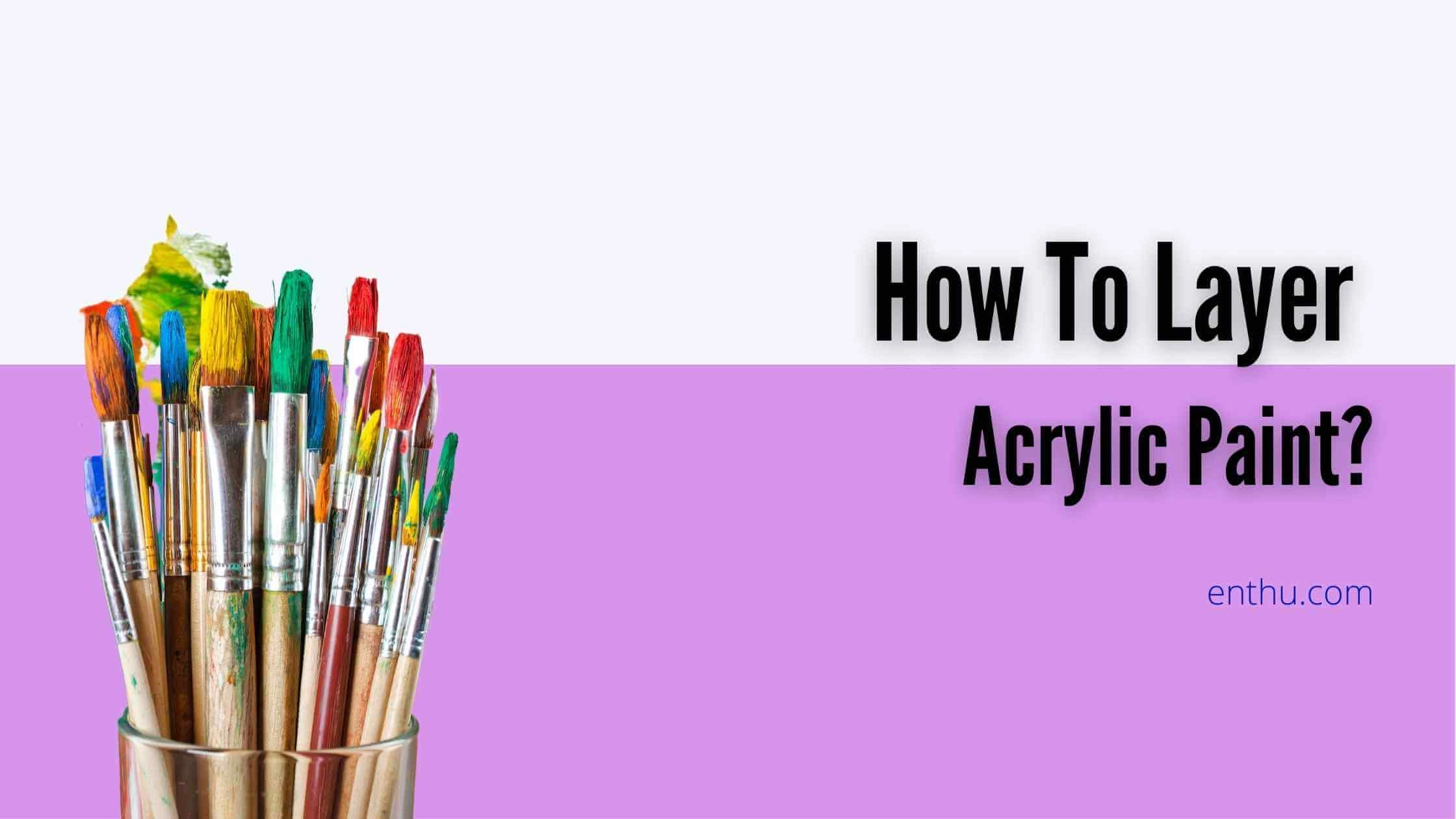Layering in acrylic paint on canvas is a technique used by artists to add depth, texture, and dimension to their artwork. To layer acrylic paint on canvas, start with a base layer of paint and let it dry completely.
Then, add subsequent layers of paint on top of the base layer, allowing each layer to dry before adding the next. You can use different colors or shades of the same color to create a layered effect.
Blend the layers together using a dry brush or a palette knife to create a smooth transition between the colors. You can repeat this process to add as many layers as you want until you achieve the desired effect.
- 🎨 Is Acrylic Paint Easy to Layer?
- Conclusion
- FAQ’s
- 1. What is acrylic paint layering?
- 2. How do you prepare your canvas for layering acrylic paint?
- 3. What are the best brushes for layering acrylic paint?
- 4. How do I mix acrylic paint for layering?
- 5. What techniques can I use for layering acrylic paint?
- 6. How long should I wait between layers of acrylic paint?
- 7. Can I layer acrylic paint on top of oil paint?
- 8. What mistakes should I avoid when layering acrylic paint?
- 9. How can I create depth with layered acrylic paint?
- 10. Is it necessary to use a medium when layering acrylic paint?
🎨 Is Acrylic Paint Easy to Layer?
Yes, acrylic paint is quite easy to layer because it dries quickly, unlike oil or watercolor. This allows you to add new colors or shades without waiting too long, making it perfect for building depth and creating smooth blends.
You can experiment with thin or thick layers to achieve different textures and effects. Using mediums can also help adjust the paint’s thickness and finish, making layering even easier. With a little practice and patience, acrylics let you create vibrant, layered artwork full of depth and character. ✨

1. How Many Layers Should I Do for Acrylic Painting?
There is no fixed number of layers you should do for acrylic painting as it depends on the style and technique you want to achieve. However, as a general guideline, it is recommended to start with a base layer.
Then, add subsequent layers until you achieve the desired level of depth, texture, and dimension. It is essential to allow each layer to dry completely before adding the next to avoid smudging and mixing of colors.
You can experiment with different colors, shades, and techniques to create unique effects. As you gain more experience with acrylic painting, you will develop your own style and approach to layering.
2. How Long Should You Wait Between Layers of Acrylic?
The length of time you should wait between layers of acrylic paint depends on several factors, such as the thickness of the paint, humidity, temperature, and the brand of paint used.
As a general rule, you should wait for each layer to dry completely before applying the next layer. This can take anywhere from a few minutes to several hours, depending on the above factors. Thin layers of acrylic paint can dry within minutes, while thicker layers may take longer to dry.
It is also essential to consider the room's humidity and temperature, as high humidity and low temperatures can slow down the drying process. A good practice is to wait at least an hour between layers and to test if the paint is completely dry by touching it lightly with your finger. If it feels dry and not tacky, it is safe to apply the next layer.
3. Steps to Add Layers to Acrylic
Prepare your Canvas
Make sure your canvas is clean, dry, and free of any dust or debris.
Choose Your Colours
Select the colors you want to use for your painting. You can use multiple colors to create a layered effect.
Start with a base layer.
Apply a thin layer of paint on your canvas, using a brush or a palette knife. Allow it to dry completely.
Add subsequent layers
Once the base layer is dry, apply another layer of paint on top of it. You can use a different color or a lighter/darker shade of the same color. Let each layer dry before adding the next.
Repeat the process
Keep adding layers and allowing them to dry until you achieve the desired effect. You can experiment with different colors, textures, and techniques to create a unique look.
Blend the layers
Once the layers are dry, use a dry brush or a palette knife to blend the layers together, creating a smooth transition between the colors.
Add details
Once you have the desired number of layers, you can add details such as highlights, shadows, and texture to your painting.
Remember to let each layer dry completely before adding the next one. You can also use mediums to add texture and thickness to your paint layers. With practice, you can master the art of layering acrylic paint to create stunning artwork.
4. Layering Techniques in Art
Layering techniques in art refer to the process of adding multiple layers of different media, colors, or textures to create depth, dimension, and complexity in a work of art. Here are some common layering techniques in art:
Glazing
A technique where a thin, transparent layer of paint or medium is added on top of another layer to create a translucent effect.
Scumbling
A technique where a dry brush is used to apply a thin layer of paint over another layer to create a textured effect.
Impasto
A technique where thick layers of paint are applied with a palette knife or brush to create a three-dimensional effect.
Washes
A technique where a thin layer of watered-down paint is applied over another layer to create a transparent effect.
Collage
A technique where different materials, such as paper, fabric, or photographs, are layered together to create a mixed-media artwork.
Sgraffito
A technique where layers of paint are scraped away with a tool to reveal the underlying layers and create a textured effect.
Underpainting
A technique where a base layer of paint is applied to create a foundation for subsequent layers. These layering techniques can be used alone or in combination with each other to create a range of effects and styles in painting and other forms of art.
These layering techniques can be used alone or in combination with each other to create a range of effects and styles in painting and other forms of art.
5. Types of Layering Methods in Acrylic Painting
Direct layering
This is a technique where a new layer of paint is applied directly on top of the previous layer after it has dried. It is one of the most common layering methods in acrylic painting and is used to build up color and texture.
Indirect layering
This is a technique where a layer of paint is applied, allowed to dry, and then a new layer of paint is applied on top of it. This method is used to create smooth and translucent effects, such as glazes.
Wet-on-wet layering
This is a technique where a new layer of paint is applied while the previous layer is still wet. It is used to blend colors together and create soft transitions.
Drybrush layering
This is a technique where a small amount of paint is applied to a dry brush, and then the brush is dragged over the surface of the painting to create a textured effect. This method is used to add highlights, shadows, and details.
Scumbling layering
This is a technique where a dry brush or a sponge is used to apply a thin layer of paint over another layer to create a textured effect. It is used to add depth and dimension to a painting, such as in landscapes and still-life compositions.
Conclusion
Layering acrylic paint is a skill that enhances the depth and vibrancy of your artwork. By understanding the techniques and best practices for layering, you can elevate your painting style and create stunning visuals. Experimentation and practice are key to mastering this technique, so don’t hesitate to try different approaches!
FAQ’s
1. What is acrylic paint layering?
Acrylic paint layering is a technique used to build depth and dimension in artwork by applying multiple transparent or semi-transparent layers of paint on top of one another. This method allows artists to create new colors and textures, enhancing the overall visual appeal of the piece.
2. How do you prepare your canvas for layering acrylic paint?
To prepare your canvas for layering acrylic paint, start by ensuring it is clean and dry. You may apply a base coat of gesso to create a smooth surface and improve paint adhesion. Allow the gesso to dry completely before starting your layering process.
3. What are the best brushes for layering acrylic paint?
The best brushes for layering acrylic paint are flat, round, and filbert brushes. Flat brushes are excellent for broader strokes and blending, while round brushes are perfect for details. Filbert brushes combine characteristics of both, making them versatile for layering techniques.
4. How do I mix acrylic paint for layering?
To mix acrylic paint for layering, start with a small amount of paint on your palette. Use a palette knife or brush to blend colors, adding a medium like acrylic glazing medium to achieve desired transparency. Always test your mixture on a scrap piece of paper before applying it to your artwork.
5. What techniques can I use for layering acrylic paint?
There are several techniques you can use for layering acrylic paint, including glazing, scumbling, and wet-on-wet layering. Glazing involves applying a thin, transparent layer over a dried layer for luminosity. Scumbling entails using a dry brush to apply a lighter color over a darker one, while wet-on-wet involves adding wet paint directly onto wet paint for a blended effect.
6. How long should I wait between layers of acrylic paint?
The drying time between layers of acrylic paint typically ranges from 15 minutes to an hour, depending on the thickness of the paint and environmental factors like humidity and temperature. It's essential to ensure that the layer underneath is completely dry before applying the next layer to avoid blending.
7. Can I layer acrylic paint on top of oil paint?
Layering acrylic paint on top of oil paint is not recommended, as oil paint dries slowly and can lead to issues such as cracking or peeling. It's best to use only acrylics or to ensure that the oil paint is fully dried and cured before attempting to layer acrylics.
8. What mistakes should I avoid when layering acrylic paint?
Common mistakes to avoid when layering acrylic paint include applying layers that are too thick, not allowing sufficient drying time, and using incompatible materials. Always work with thin layers and ensure each layer is dry before adding the next to achieve the best results.
9. How can I create depth with layered acrylic paint?
To create depth with layered acrylic paint, use a combination of transparent and opaque colors. Start with a darker base layer and gradually add lighter colors in transparent glazes. This approach allows the underlying tones to shine through, giving your artwork a sense of dimension and richness.
10. Is it necessary to use a medium when layering acrylic paint?
Using a medium when layering acrylic paint is not strictly necessary, but it can be highly beneficial. Mixing a glazing medium or retardant into your paint can improve transparency, workability, and drying times, leading to more successful and smooth layering outcomes.
Feel free to experiment and find the techniques that work best for you as you explore the expressive possibilities of layered acrylic painting!



.png)


Comments